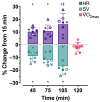Effect of Work-to-Rest Cycles on Cardiovascular Strain and Maximal Oxygen Uptake during Heat Stress
- PMID: 36901590
- PMCID: PMC10001546
- DOI: 10.3390/ijerph20054580
Effect of Work-to-Rest Cycles on Cardiovascular Strain and Maximal Oxygen Uptake during Heat Stress
Abstract
Cardiovascular drift-a progressive increase in heart rate (HR) and decrease in stroke volume (SV) during prolonged exercise-is exacerbated by heat stress and thermal strain, and often accompanied by a decrease in work capacity (indexed as maximal oxygen uptake [V.O2max]). To attenuate physiological strain during work in the heat, use of work:rest ratios is recommended by the National Institute for Occupational Safety and Health. The purpose of this study was to test the hypothesis that during moderate work in hot conditions, utilizing the recommended 45:15 min work:rest ratio would result in cardiovascular drift 'accumulating' over consecutive work:rest cycles and accompanying decrements in V.O2max. Eight people (5 women; (mean ± SD) age = 25 ± 5 y; body mass = 74.8 ± 11.6 kg; V.O2max = 42.9 ± 5.6 mL·kg-1·min-1) performed 120 min of simulated moderate work (201-300 kcal·h-1) in hot conditions (indoor wet-bulb globe temperature = 29.0 ± 0.6 °C). Participants completed two 45:15 min work:rest cycles. Cardiovascular drift was evaluated at 15 and 45 min of each work bout; V.O2max was measured after 120 min. On a separate day, V.O2max was measured after 15 min under identical conditions for comparison before and after cardiovascular drift occurred. HR increased 16.7% (18 ± 9 beats·min-1, p = 0.004) and SV decreased 16.9% (-12.3 ± 5.9 mL, p = 0.003) between 15 and 105 min, but V.O2max was unaffected after 120 min (p = 0.14). Core body temperature increased 0.5 ± 0.2 °C (p = 0.006) over 2 h. Recommended work:rest ratios preserved work capacity but did not prevent the accumulation of cardiovascular and thermal strain.
Keywords: cardiovascular drift; occupational health and safety; work capacity; work:rest ratios.
Conflict of interest statement
The authors declare no conflict of interest. The National Institute for Occupational Safety and Health had no role in the design of the study; in the collection, analyses, or interpretation of data; in the writing of the manuscript; or in the decision to publish the results.
Figures




References
-
- Maresh C.M., Sökmen B., Armstrong L.E., Dias J.C., Pryor J.L., Creighton B.C., Muñoz C.X., Apicella J.M., Casa D.J., Lee E.C., et al. Repetitive box lifting performance is impaired in a hot environment: Implications for altered work-rest cycles. J. Occup. Environ. Hyg. 2014;11:460–468. doi: 10.1080/15459624.2013.875185. - DOI - PubMed
Publication types
MeSH terms
Substances
Grants and funding
LinkOut - more resources
Full Text Sources
Medical
Miscellaneous

